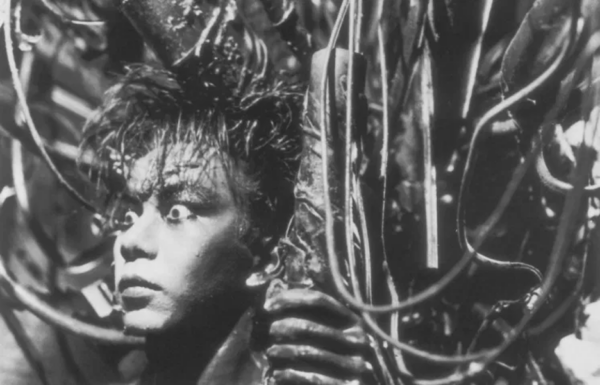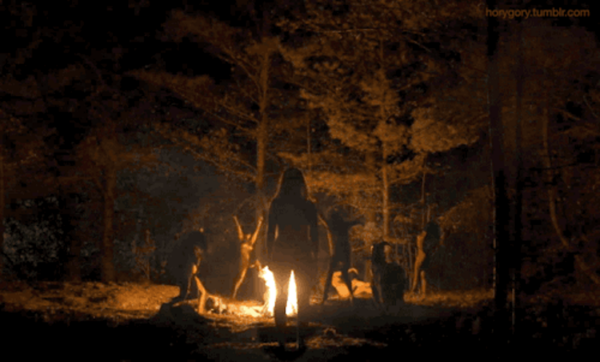
Tetsuo: The Iron Man (1989) Directed by Shinya Tsukamoto
1. Mike Corrao’s Rituals Performed in the Absence of Ganymede (11:11 Press)
This monster is meat. Blackblood, fiber, fluid, skin, and metal. The body is barely held together. Rears its head as the minotaur. Says, “Let sinews sew me together again and return my eyes to open.” This swollen dying body becomes decaying text. The slow leak of blood. Of fuel. “With bloody and hoarse cords vibrating. I remove what is contained within my self. Gut becoming text.”
The speaker is body, is text, is assemblage as described by Deleuze and Guattari:
“One side of a machinic assemblage faces the strata…it also has a side facing a body without organs, which is continually dismantling the organism, causing asignifying particles or pure intensities to pass or circulate, and attributing to itself subjects that it leaves with nothing more than a name as the trace of an intensity.”
This speaker as trace, as ghost, within the corpse machine. Corrao writes,
“I’ve cut a slit across my abdomen and removed the vestigial tissue (liver, stomach, intestines, etc.). I tell you that the contents remaining are what I’ve deemed vital to my existence. You acknowledge this and sift through the empty space of my dripping cavities.”
This empty wet orifice disfigures the grotesque body. In “A Cyborg Manifesto” Donna Haraway says of the hybrid organism:
“The relationships for forming wholes from parts, including those of polarity and hierarchical domination, are at issue in the cyborg world. Unlike the hopes of Frankenstein’s monster, the cyborg does not expect its father to save it through a restoration of the garden—that is, through the fabrication of a heterosexual mate, through its completion in a finished whole, a city and cosmos.”
The minotaur inhabits a labyrinth of glitches. There is a maze of light. Corraro writes:
“Columns flicker between doric and ionic. Brutalist modules disappear and reappear. The interior slithers in ever-changing patterns. At the center, asterion builds an intricate altar from coral and quartzite. Carving reliefs facedown with her aging horns. You cannot bring yourself to interrupt the process of materializing, to halt the rhizome’s construction.”
The voice we are hearing is a ghost in the machine, bound inside the physical and observing the body’s decay. This decay happens as soon as the body is entered. Is always happening. Is always forcing the voice out and into something new. But this new ideal body doesn’t exist.
Haraway says in “A Cyborg Manifesto,”
“Pre-cybernetic machines could be haunted; there was always the specter of the ghost in the machine. This dualism structured the dialogue between materialism and idealism that was settled by a dialectical progeny, called spirit or history, according to taste. But basically machines were not self-moving, self-designing, autonomous. They could not achieve man’s dream, only mock it. They were not man, an author to himself, but only a caricature of that masculinist reproductive dream.”

2. Lucía Estrada’s Katabasis translated by Olivia Lott (Eulalia Books)
Movement through shadow. Through water. On stairs. Ever moving on at night and in sunlight. There is movement without a body. There is a body made of fish. Mouths made of holes. A body made of bees that rises in an angry cloud. There is an absence in presence. Something ethereal: “To think of nothing. To be nothing. Much less to feel.”
Sylvia Plath stands beyond gesturing, “Is she dead, is she sleeping?/Where has she been,/With her lion-red body, her wings of glass?”
By invoking movement in title, there is an inevitable stasis. Or a brackish stagnation. In “Fragments of a Journal in Hell” Antonin Artaud says, ”I am struck by the idea of an unexpected and fixed space where normally all is movement, communications, interferences, trajectory.” Katabasis is this.
When the body does appear it flits away. “For a while now the sea ripples in my ear, wipes out bridges I built in my dreams; salt bites at the root of my tongue; house roof, garden clovers, corners where the hare slips away.” The body is slippery. Hard to grasp: “Take this thread of shadow and wrap it around you.” Certain rituals must be completed to continue down this winding path. But progress is slow.
Ariadne is invoked and we are suddenly in a maze. Can’t see: “Beyond dream, beyond my own narrow labyrinth.” And just a few poems later, there is “Nothing to see. Not even words.”
Plath says, “There is nothing between us.”

My Neighbor Totoro (1988) Directed by Hayao Miyazaki
3. Hiroko Oyamada’s The Hole translated by David Boyd (New Directions)
You will want to roll around in the tall grass. Hear the crickets chirping louder and louder. “A single cicada shook its abdomen clumsily as it began to cross the garden, stopping to release a stream of clear fluid. Then began to buzz. Chiii, chit, chit.” And as the growing sound of insects increases large holes appear. You will disappear. Will wonder what kind of wild animal has dug down so far? Is the strange creature in the hole with you? Things don’t ever quite make sense. Children (or are they ghosts?) linger by the river, playing and hiding in these holes.
“I could smell something, maybe the grass or the river. I let it fill my lungs and body.”
I imagine Oyamada’s children running alongside Hiromi Ito’s in Wild Grass on the Riverbank when she writes,
“By late summer, everyone on the riverbank was dead,
Not just the once living creatures, but the summer grass, the rusted bicycles, the summer grass,
Cars without doors or windows, the warped porn magazines, the summer grass,
Empty cans with food stuck inside and empty bottles full of muddy water,
Girl’s panties and condoms, the dead body of father, and so much summer grass”
Or with Yoko Tawada’s The Emissary when she writes, “Every morning, Yoshiro rented a dog from the Rent-a-Dog place on the corner to run with along the riverbank for about half an hour.”
Oyamada writes of the cicadas, “Their cries were so close that I wondered if they were coming from inside of me– if maybe I had swallowed one.”

The Witch (2015) Directed by Robert Eggers
4. Helena Boberg’s Sense Violence translated by Johannes Göransson (Black Ocean)
Poison ballad. It wants to be read hard and fast. At other times it is sing-song and light, like girls’ hair in the wind. Red dresses. The eye-slit. The mouth eats sickly sweet summer fruit.
A fetus is like a tongue. Shimmering snakes have a sinister aura. They hurt “only a cunt” and make “intestines burst.”
Like Christina Rosetti’s Goblin Market mixed with lunacy and the smell of cigarette smoke.
Rosetti’s Laura at the height of her hysteria:
“She suck’d and suck’d and suck’d the more
Fruits which that unknown orchard bore;
She suck’d until her lips were sore”
But unlike Rosseetti’s Laura who is led to action, Boberg’s speaker has violence done to her body. When given an abortion, the extracted fetus is described as “Petals of blood/ blossom/ in formaldehyde.”
The natural world fuses with the bodies: “The mold flowers/ fully bloomed/ coronary artery.”
Until she gains some control over the body, “I am dancing in the middle/ like a naked animal” However, this agency seems to disappear again. She yearns “To get to float away in a breathtaking, blackening, unspeakable dream”.

Saturn Devouring His Sun (1819-1823) Francisco Goya
5. Kimiko Hahn’s Foreign Bodies (W.W. Norton & Company)
A devouring. We begin with x-rays of objects in throats. How to pull them out? How to extract pins from young lungs? So delicate. Hahn writes, “How to preserve all two thousand foreign bodies?” Collecting and categorizing the objects in the Mutter Museum are objectives set up in the beginning of Foreign Bodies. She must build a cabinet for the curiosities which, “each child had hoarded some thing// in her inmost chest,”
Yet she comes to elegy for her mother. She writes, “Saturn devoured his children// to save his own skin from divine betrayal./ Snow White’s stepmother devoured//the girl’s lung and liver–or so she believed// My youngest, after Mother died, figured,//Grandma now lives inside my tummy”.
Lists of items sit side by side with morbid cravings and the haul of a hoarder. She tries to build her mother back into existence with the objects. Even dust: “Nowadays I lie down in the sunlight/ to see my mama/ moting around as sympathetic ash.” but not even ash, bonsai, pomegranates, pruning shears, puppies, nothing compares to a pin stuck in the lung.